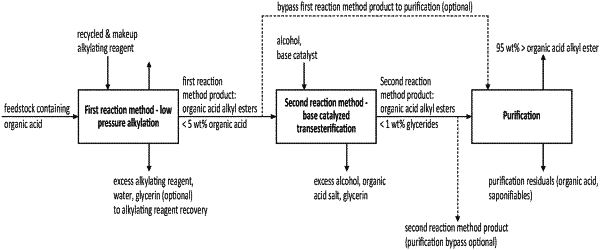| CPC C07C 67/08 (2013.01) [B01J 31/0212 (2013.01); B01J 31/2208 (2013.01); B01J 2231/49 (2013.01); B01J 2531/48 (2013.01); B01J 2531/49 (2013.01); B01J 2531/842 (2013.01); C07C 2601/20 (2017.05)] | 46 Claims |

|
1. A method or an industrial process for producing an organic acid alkyl ester comprising:
conducting an esterification reaction between:
(i) a feedstock comprising an organic acid; and,
(ii) an alkylating reagent, with or without catalyst,
wherein the esterification reaction conditions comprise a temperature of between about 100° C. to 400° C. and a pressure of between about 0.1 barg to 355 barg, to generate the organic acid alkyl ester which may comprise unreacted or remaining saponifiables,
wherein the alkylating reagent comprises one or multiple alkylating compounds or reagents,
wherein the one or multiple alkylating compounds or reagents comprises: a monohydric alcohol, a polyhydric alcohol, an alkyl carbonate, an alkyl sulfate, an alkyl ether, an alkyl sulfate, an alkyl halide, an alkyl ester or a combination thereof, and
wherein the minimum amount of organic acid contained in the feedstock is about 50 parts per million (ppm), or between about 45 to 55 ppm, or between about 40 to 60 ppm,
and wherein the esterification reaction takes place in
at least one pressurized vessel or stage and a pumparound pressure loop,
wherein the at least one pressurized vessel or stage is incorporated into the pumparound pressure loop, and the pumparound pressure loop operates at a higher pressure than the pressurized vessel or stage such that products that leave the pressurized vessel or stage are continuously circulated back to the pressurized vessel or stage through the pumparound pressure loop,
wherein the reaction rate within the pumparound pressure loop is higher than within the pressurized vessel or stage,
wherein the relative volume of the pumparound pressure loop is less than or equal to about 20%, or less than or equal to about 10% and 50%, of the pressurized vessel or stage volume, and
wherein the relative pressure of the pumparound pressure loop is at least about 2% greater, or at least between about 0.5% and 5% greater, than the operating pressure of the pressurized vessel or stage.
|